Magnetic letters are pure MAGIC. I can’t tell you how many times I’ve seen a student struggle with a word in a book, and then read the same exact word made out of magnetic letters!
Okay, so maybe they aren’t magic. But they are an amazing tool for beginning readers! Magnetic letters allow teachers and kids to isolate individual letters or word chunks, making it easier for students to decode a word. I have been using magnetic letters a lot with the intervention students I see. They can generally decode the simple books we read (at a Level AA or A) by attending to meaning and looking at the pictures. This is great, but it’s time for them to begin decoding.
Spanish is a syllabic language, so I want my students to begin to see words as a combination of syllables. Using magnetic letters has been really effective with teaching my students how to break words into syllables, and then syllables into their individual sounds. I’m going to walk you through the (very simple) Spanish word study activity that we do on a daily basis. Even if you don’t teach in Spanish, this may still give you some ideas about how to use magnetic letters.
1. I make a word for students out of magnetic letters. I always start with 2 syllable words (with open syllables). If we are studying a certain syllable (such as syllables with the letter “m”), I try to include one of those syllables in the word. The word below is “mesa” (table).

2. Next, I say to the students, “Break the word!” I don’t know why, but the idea of “breaking a word” really gets them excited! They physically separate the word into its syllables.
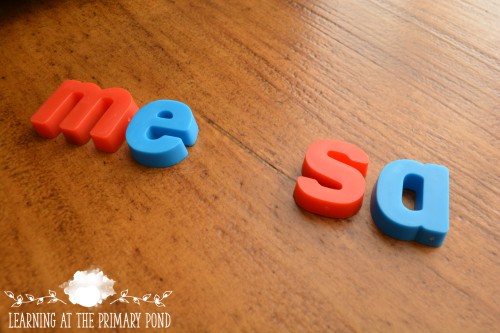
3. Then, I prompt students to read the first syllable of the word. At the beginning, many of them have to say the individual letter sounds and then blend them together. It might sound like this: “/m/ /e/….me.” I have students repeat that syllable a few times and tell them to “put it in their brains.” Because they are decoding so slowly at this point, they often forget the first syllable by the time they have read the second one.

4. Students must then read the final syllable of the word. Again, I encourage them to “put it in their brains” and say it a few times.

5. Last, I have them say the first syllable and the last syllable together. “Me…sa. Mesa!” Then, they move the two syllables back together and read the word once more: “Mesa.”
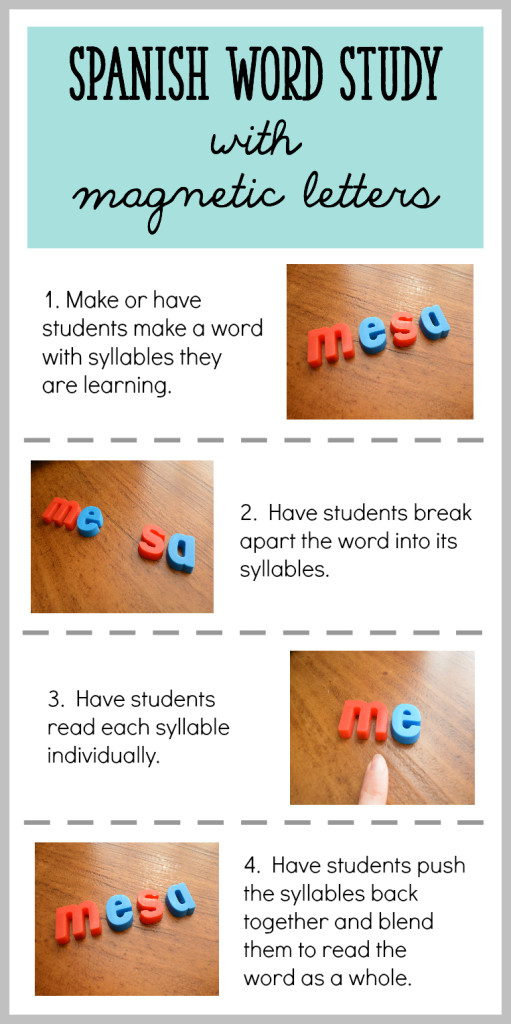
This is certainly not a complicated or groundbreaking strategy, but I’ve found it to be super effective in teaching students that they can decode words by breaking them into their syllables. I always make sure to explicitly reference this strategy when they’re reading “real” words in the context of a book.
After students have mastered 2 syllable words, we move on to 3 syllable words, and eventually words with more complicated syllables (like closed syllables and syllables with blends). To give students more practice with their syllable and word reading fluency, we also use my Escaleras de fluidez program. To read more about it, click on the image below.
This “word breaking” routine takes just a few minutes and is a great warm-up before diving into a new book. It’s a great addition to guided reading, but it can also be used during whole group instruction. You will just need to use a document camera or alphabet letters on an interactive whiteboard screen so that all students can see what you are doing.
If you teach in English, you can use this same strategy to teach CVC words, word families, or words with an -ing, -s, -ed / other inflectional ending.
Do you use magnetic letters in a different way? I’d love to hear your ideas – just comment below!


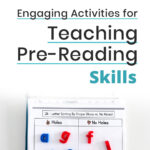
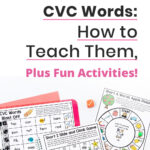
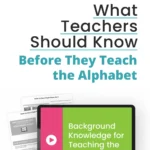


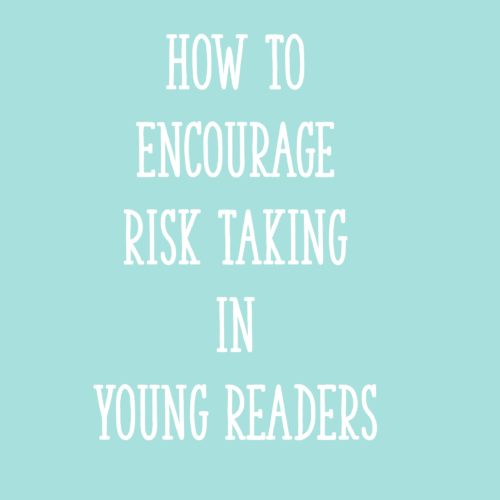






Hey!
I just recently discovered your blog and I LOVE it! I have been teaching for 11 years, but this is my first year as a Dual Language teacher. My partner teacher, Emma, teaches the Spanish side and she is a first year teacher, so I am constantly trying to find resources that make sense to both of us. Thank you for sharing your ideas!
L.
Hi Luisa! I’m so glad it’s helpful! I taught dual last year and I know it can be difficult to find resources. Thanks for stopping by and leaving a comment! 🙂
Alison
Great blog post! One thing i have found difficult to find is magnetic letters that contain the Spanish alphabet. Does anyone know where i can buy them?
I think Really Good Stuff has some Spanish things like that! 🙂
Alison
Thank you so much! We have just launched a DLI school. We are teaching Spanish as the target language. This clarifies things. What guided materials do you recommend for Kinder?
Hi Mirna! Benchmark Books has some great Spanish materials. The Sistema de la intervención de lectura by Hopscotch is another great resource!
Alison